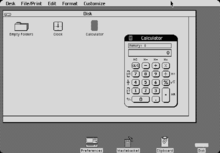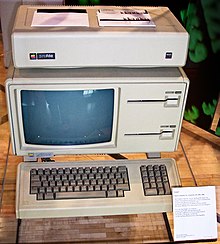Apple Lisa

The Apple Lisa (also called just "Lisa" and "The Lisa"; and "Lisa," of " Locally Integrated Software Architecture ") from 1983 was one of the first personal computer , via a mouse and an operating system with a graphical user interface in a monochrome black and white display. Because of the high price of around 10,000 US dollars, the computer sold poorly, and Apple stopped production in 1984. This year Apple brought another computer with a graphical user interface onto the market, the simpler but also much cheaper Macintosh ; this was at least in the medium term a success for the Californian computer company.
meaning
Until the early 1980s, computers were usually operated using a keyboard on a command line. Lisa was - next to the little-known Xerox Star from 1981 - the first commercial computer to offer a graphical user interface with desk character and mouse operation . Steve Jobs , who had Lisa developed as the successor to the popular Apple II , got the inspiration for this while visiting Xerox PARC in 1979 when he saw the research computer Xerox Alto from 1974. Lisa was in competition with the recently released PC from IBM . With the introduction of Microsoft Windows in 1985 , Microsoft offered a basically comparable graphical user interface for IBM PC-compatible computers , but in the first few years this was considered to be not very mature and it was only with version 3.0 from around 1990 that it gradually became a serious competitor to Apple's products.
The New York Times wrote on January 19, 1983, just before the computer came out:
“Instead of typing commands, you show pictures on the screen by moving a hand-held device called a mouse on the surface of the desk, close to the computer. As the mouse moves, the cursor - that is, the arrow that points to certain points on the screen - moves accordingly. "
The London Sunday Times wrote on January 25, 1983:
“Today we're taking a closer look at last week's two major releases - the European debut of the IBM Personal Computer and the premiere of Apple's Lisa. From an international perspective, Lisa was the far more exciting event: a new computer to which the two overused advertising slogans 'user-friendly' and 'revolutionary' actually apply. "
That Lisa represented a milestone in computer technology is also clear from a very positive experience report by a computer editor from 1983:
“The real hallmark of Lisa is the 'mouse'. This small hand-held device, connected to the computer by a thin cord, is Lisa's 'man / machine interface'. With the trackball and the button, the mouse enables 'intuitive' operation. The cursor is moved on the screen by rolling on the tabletop, a command word or a symbol is 'clicked', and Lisa has already been given an order without touching the keyboard or having to master complicated command languages. "
Origin of name
While in the supplied original documents of the Lisa OS was merely of "The Lisa" is mentioned, was officially claimed by Apple that it is at Lisa is a acronym for L ocal I ntegrated S oftware A rchitecture handle, ie "local integrated software architecture." Since Steve Jobs' first daughter, who was born in 1978, was named Lisa Jobs, it is generally assumed that the name has a personal meaning and that it is therefore a backronym . Later appeared in the IT world and the ironic acronym L et's I nvent S ome A cronym on for LISA.
hardware
The Motorola 68000 including MMU with 5.09376 MHz, a 16 ‑ bit data bus and a 24 ‑ bit address bus were used as the processor (CPU) . 512 kB of working memory (RAM) were soldered onto a replaceable memory board from Apple ; in the configuration with 1 MB RAM, two memory boards with 512 kB of memory each were installed. By replacing the two memory boards with a single 2 MB memory board from Sun Remarketing, the user was able to upgrade the computer to a maximum of 2 MB RAM. At least 1 MB RAM was required to run Lisa software, and 512 kB was enough to run MacWorks. Later, with hardware modifications of the Lisa CPU / MMU board, there was also an upgrade to 4 MB RAM. This was followed by third-party CPU boards with a 12, 16 or 18 MHz 68000 processor and up to 8 MB (faster) RAM directly on the CPU board, which, however, could only be used with MacWorks, as Lisa OS only supported the original CPU and couldn't use more than 2MB of RAM.
The Lisa initially had two 5¼-inch floppy disk drives , each with 871 kB of storage capacity . An external hard drive , called Apple ProFile (see picture on the right on the Lisa), could be connected externally and offered a storage capacity of 5 or 10 MB, depending on the model.
As early as 1984, the Lisa 2 was a revised model that replaced the two 5¼-inch floppy disk drives with a single, more modern 3.5-inch drive with 400 kB of storage capacity. The Lisa 2 had an internal 10 MB hard drive, but no external connection for an Apple ProFile. Later there was also an upgrade to an 800 kB 3.5 inch drive, which could only be used with MacWorks.
software

Lisa OS was used as the operating system , alternatively also Xenix , a Unix variant from Microsoft (later transferred to SCO ), and UniPlus + UNIX from UniSoft. In addition, from the Lisa 2 with MacWorks, there was also the option of using the Macintosh system software and thus Macintosh programs.
The graphical user interface was called Lisa Shell and had large icons that represented a desk , which later - in the PC area with Microsoft Windows not until the 1990s - became the industry standard that is still common today .
Six office applications were included: LisaCalc , LisaGraph , LisaDraw , LisaWrite , LisaProject and LisaList . The LisaTerminal program cost DM 850 extra. Additional programming languages were BASIC , COBOL and Pascal .
The complete source code will be published as open source software in 2018 - without the American Heritage dictionary of the Lisawrite writing program.
Economic failure
Apple Lisa was very expensive at 9,995 US dollars (in Germany around 30,000 DM, in Austria 200,000 Schillings , based on today's purchasing power around 28,000 euros) and sold poorly despite the good features and the highly innovative concept at the time. In order to at least be able to write them off from the tax , 2700 unsaleable Apple Lisa were simply buried in 1989 in a garbage dump in the US state of Utah . The successor Lisa 2 (1984) was renamed the Macintosh XL in early 1985 (after the introduction of the small Macintosh, also known as the “shoe box” ) .
Popular culture
In the Simpsons episode 497 ( friend request from Lisa , in the original: The D'Oh-cial Network . Season 23, episode 11) Lisa Simpson can be seen in a recording as she satirical on an old Lisa of the brand "Mapple" of the electronics manufacturer Apple - works.
literature
- W. Owen Linzmayer: Apple - strictly confidential. Midas, Zurich 2000, ISBN 3-907100-12-3
Web links
- Experience report from October 1983
- Articles with pictures of the device when open (English)
- Apple Lisa 2/10 in the HomeComputer Museum (English)
- Link to Apple History - Description of the individual devices
- Original video of an Apple Lisa product demonstration from 1984 on American television - GUI is shown in detail (English)
Individual evidence
- ↑ Ben Schwan: Apple Lisa: When Apple let the mouse off the leash. In: Heise online . 19th January 2018 . Accessed March 27, 2020 .; Quote: “The Lisa was a flop, but it laid the foundations for the success of the Macintosh. ... the "Locally Integrated Software Architecture", in short: Lisa ... “.
- ^ Gerhard Fischer: First experiences with LISA. 65xx Micro Mag, No. 33, October 1983, archived with Computer History Online
- ↑ Torsten Beyer: On the extinction of diversity. ( Memento of August 17, 2000 in the Internet Archive ) iX , 1/1999


